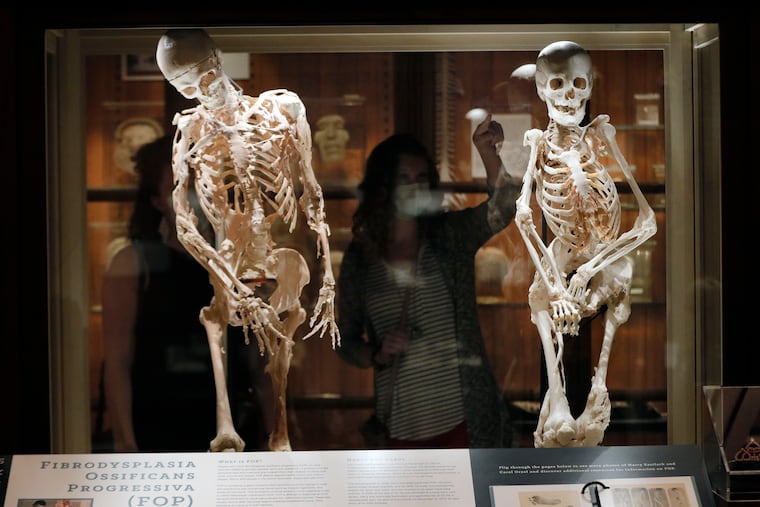New Mütter Museum policy on human remains is a disgrace
In its campaign to preserve the dignity of the dead, the leadership of the College of Physicians of Philadelphia has forgotten how to treat the living with respect.

The Mütter Museum of the College of Physicians of Philadelphia was founded in 1863 through the donation of tissue specimens, medical tools, and anatomical models by Thomas Dent Mütter, who had been the chair of surgery at Jefferson Medical College. In the ensuing 160 years, both the museum’s collection of human tissue specimens and its popularity have grown exponentially.
It’s true that many historical specimens in the collection were acquired without informed consent from the donors. Many others were acquired from other museums and hospitals that no longer wanted to care for their teaching collections; these “orphaned” specimens faced destruction if not accepted into the museum’s collection.
New leadership — specifically, CEO Mira Irons and executive director Kate Quinn — has decided that instead of displaying anatomical and pathological tissue specimens, the museum will transition to an institution concerned with “health and well-being.” (It should be noted that both Irons and Quinn have expressed deep distaste for the museum, both among museum staff and in print.)
In so doing, the museum is critically reevaluating the need for the display of human remains for educational purposes — or even depictions of human remains — unless there was explicit consent from the donor.
As a result, college staff have been instructed to remove specimens from the teratology exhibition at the museum, which highlights fetal defects now rarely seen due to advances in obstetrics. Staff were also informed that even literary illustrations of human remains were no longer to be used for educational purposes. However, Quinn stated that “more recent donations that had enthusiastic consent will likely remain unchanged” in a recent Philadelphia Magazine article.
Although that may be the museum’s public stance, clearly that policy is in name only — just ask Barbara Kotzin.
Kotzin has scoliosis so severe her spine formed an S-shape. However, Kotzin’s condition was partially corrected through the surgical insertion of hooks and rods in her back in 1996. A visit to the Mütter Museum, one of the few institutions in the United States that curates and displays human tissue specimens, convinced her to donate her skeleton to the collection after her death, with her full consent and enthusiastic agreement to put a little of herself on display. Since 1996, she has worked closely with curators to facilitate the donation.
Kotzin even arranged and earmarked funds for the postmortem defleshing of her skeleton, brought her executor to visit the Mütter’s scoliosis skeletons, and memorialized her plans in her will. And yet, when Kotzin reached out recently to Quinn, she was flatly told that the museum didn’t have any paperwork on her and that the museum is not currently receiving new acquisitions. A subsequent letter explaining her situation, sent individually to each of the board of trustees of the college, was met with deafening silence. Now 74, Kotzin is at a loss as to how to proceed.
The failure to meet their obligations to donors like Kotzin suggests that college leadership is interested in respecting the wishes of the dead — but only when such wishes agree with their predetermined narrative that the public has no business viewing anatomical and pathological specimens.
Supporters of the Mütter Museum have no qualms with a fair and clear-eyed evaluation of the collection and the return of specimens to family members if they can be identified and so wish.
Instead, Irons and Quinn have unilaterally decided to sanitize the parts of the museum that they personally find unappealing instead of allowing the public to decide, individually, if they’d like to see and learn about medical science and history in its purest form.
The museum recently hosted a town hall-style meeting (called, ironically, “Postmortem”) to gather opinions about the ethics surrounding the collection and display of human remains, underwritten by a $285,000 grant from the Pew Center for Arts and Heritage.
Instead, Quinn and Irons could have gotten all the information they needed from the deeply critical commentary and intense backlash they received on their social media platforms from fans and followers of the museum, or from some of the 35,500 people (and counting) who signed a Change.org petition calling for the preservation of the museum’s legacy — without spending a dime.
It seems that in its campaign to preserve the dignity of the dead, the leadership of the College of Physicians has forgotten how to treat the living with kindness and respect.
Don’t listen to what they say, watch what they do. And make your voice heard by signing and commenting on the petition or emailing your thoughts to the college at inquiries@collegeofphysicians.org.
Marianne Hamel is a board-certified forensic pathologist practicing in Pennsylvania and New Jersey and the chair of the Wood Institute, Library, and Museum Committee of the College of Physicians of Philadelphia.